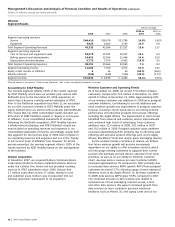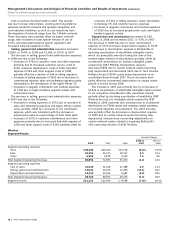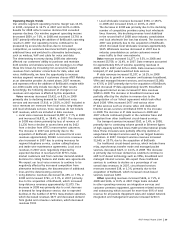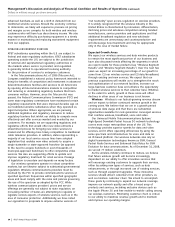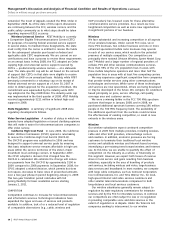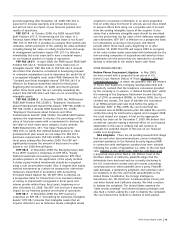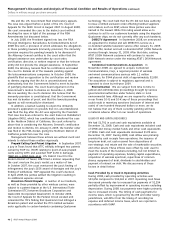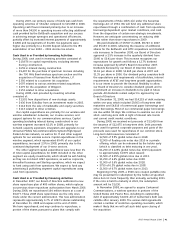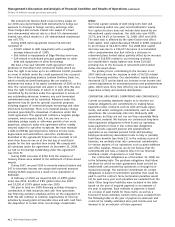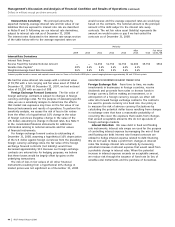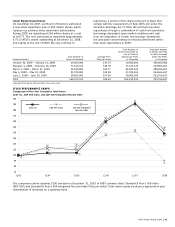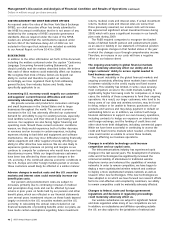AT&T Wireless 2008 Annual Report Download - page 38
Download and view the complete annual report
Please find page 38 of the 2008 AT&T Wireless annual report below. You can navigate through the pages in the report by either clicking on the pages listed below, or by using the keyword search tool below to find specific information within the annual report.
Management’s Discussion and Analysis of Financial Condition and Results of Operations (continued)
Dollars in millions except per share amounts
36
| AT&T Annual Report 2008
remanded. The Court of Appeals vacated the E911 Order in
September 2008. As of the date of this report, discussions
are continuing between the FCC, wireless carriers, and the
public safety community as to what steps should be taken
regarding improved E911 accuracy.
Wireless Universal Service AT&T Mobility is currently
a Competitive Eligible Telecommunications Carrier (CETC)
for purposes of receiving federal universal service support
inseveral states. To maintain these designations, the state
must certify that the carrier is entitled to receive the funds
for the subsequent calendar year based on federal and
applicable state CETC requirements. We arecurrent on our
certifications and have a process to review these requirements
on an annual basis. In May 2008, the FCC adopted an Order
capping high-cost universal service support received by
CETCs — predominantly wireless carriers — at a statewide
level. The state-specific cap will be set based on the amount
of support that CETCs in that state were eligible to receive
in March 2008 on an annualized basis. Notably, while AT&T
previously consented to a voluntary cap on its receipt of
federal universal service support as of June 30, 2007 in
order to obtain approval for the acquisition of Dobson, this
commitment was superseded by the industry-wide CETC
cap adopted in the May 2008 Order. The industry-wide cap
was implemented in the third quarter of 2008. AT&T Mobility
received approximately $211 million in federal high-cost
support in 2008.
State Regulation A summary of significant 2008 state
regulatory developments follows.
Video Service Legislation A number of states in which we
operate have adopted legislation or issued clarifying opinions
that will make it easier for telecommunications companies to
offer video service.
California High Cost Fund In June 2006, the California
Public Utilities Commission (CPUC) opened a rulemaking
to review the California High Cost Fund B (CHCF-B).
The CHCF-B program was established in 1996 and was
designed to support universal service goals by ensuring
that basic telephone service remains affordable in high-cost
areas within the service territories of the state’s major
incumbent local exchange carriers. In September 2007,
the CPUC adopted a decision that changed how the
CHCF-B is calculated. We estimate the change will reduce
our payments from the CHCF-B by approximately $100 in
2009 compared to 2008 payments. In September 2008, the
CPUC adopted a related decision, which permits but does
not require, increases to basic rates of prescribed amounts
over a two-year phase-in period beginning January 1, 2009.
This two-year transition period concludes with full
pricing flexibility for basic residential service starting
January 1, 2011.
CO M PETIT I O N
Competition continues to increase for telecommunications
and information services. Technological advances have
expanded the types and uses of services and products
available. In addition, lack of or a reduced level of regulation
of comparable alternatives (e.g., cable, wireless and
VoIP providers) has lowered costs for these alternative
communications service providers. As a result, we face
heightened competition as well as some new opportunities
in significant portions of our business.
Wireless
We face substantial and increasing competition in all aspects
of our wireless business. Under current FCC rules, six or
more PCS licensees, two cellular licensees and one or more
enhanced specialized mobile radio licensees may operate
in each of our service areas, which results in the potential
presence of multiple competitors. Our competitors are
principally three national (Verizon Wireless, Sprint Nextel Corp.
and T-Mobile) and a larger number of regional providers of
cellular, PCS and other wireless communications services.
More than 95% of the U.S. population lives in areas with
three mobile telephone operators and more than half the
population lives in areas with at least five competing carriers.
We may experience significant competition from companies
that provide similar services using other communications
technologies and services. While some of these technologies
and services are now operational, others are being developed
or may be developed in the future. We compete for customers
based principally on price, service offerings, call quality,
coverage area and customer service.
We were a winning bidder in the FCC 700 MHz spectrum
auctions that began in January 2008, and in 2008, we
purchased additional spectrum licenses covering 196 million
people in the 700 MHz frequency band. The availability of
this additional spectrum from the auctions could increase
the effectiveness of existing competition, or result in new
entrants in the wireless arena.
Wireline
Our wireline subsidiaries expect continued competitive
pressure in 2009 from multiple providers, including wireless,
cable and other VoIP providers, interexchange carriers
and resellers. In addition, economic pressures are forcing
customers to terminate their traditional local wireline
service and substitute wireless and Internet-based services,
intensifying a pre-existing trend toward wireless and Internet
use. At this time, we are unable to quantify the effect of
competition on the industry as a whole, or financially on
this segment. However, we expect both losses of revenue
share in local service and gains resulting from business
initiatives, especially in the area of bundling of products
and services, including wireless and video, large-business
data services and broadband. In most markets, we compete
with large cable companies, such as Comcast Corporation,
Cox Communications, Inc. and Time Warner Inc., for local,
high-speed Internet and video services customers and
other smaller telecommunications companies for both
long-distance and local services customers.
Our wireline subsidiaries generally remain subject to
regulation by state regulatory commissions for intrastate
services and by the FCC for interstate services. In contrast,
our competitors are often subject to less or no regulation
in providing comparable voice and data services or the
extent of regulation is in dispute. Under the Telecom Act,
companies seeking to interconnect to our wireline


